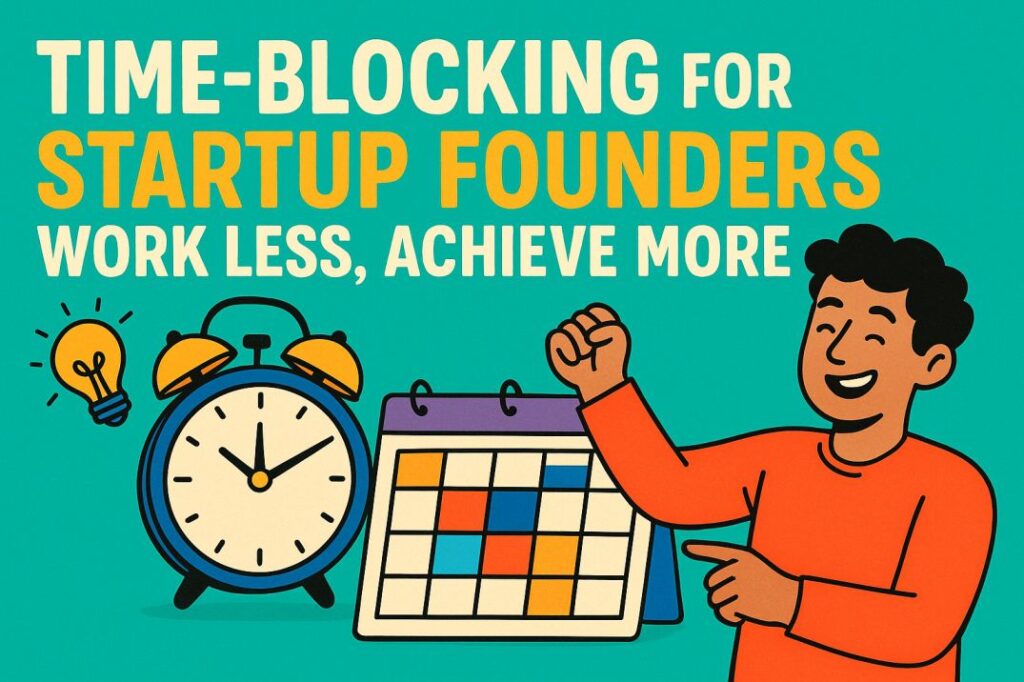Let’s be honest.
Startup life is messy. Your inbox is a dumpster fire, your to-do list grows faster than your user base, and your team thinks you’re a superhero with 48 hours in your day. Spoiler: you’re not. But what if I told you there’s a surprisingly simple trick that can make you feel like you’ve cloned yourself?
Enter: Time-Blocking.
This isn’t your average productivity hack. It’s a mindset shift, a workstyle makeover, and quite frankly, a game-changer for overwhelmed founders trying to do it all.
What the Heck is Time-Blocking, Really?
Time-blocking is the anti-chaos system for your day. It’s where you assign specific blocks of time to specific tasks—instead of working from a bottomless to-do list and putting out fires all day.
Imagine your calendar as a pizza. Time-blocking slices it up into neat, tasty chunks like “Team Strategy (10–11am)”, “Deep Work (2–4pm)” or “Marketing Review (4–5pm)”. No multitasking. No guesswork. Just delicious, focused work.
Why Startup Founders Need Time-Blocking More Than Anyone
Startup founders wear 73 hats before breakfast. From pitching to investors to fixing bugs to replying to support tickets—your role is fluid, unpredictable, and exhausting.
Time-blocking isn’t just helpful—it’s essential.
Here’s why:
- 🚫 It kills decision fatigue. You no longer ask “What should I do next?”
- 🧠 It boosts brainpower. Focusing on one thing at a time makes you smarter.
- ⏳ It gives back your time. Ironically, planning your time helps you gain time.
- 🔥 It prevents burnout. You control your calendar instead of being a slave to it.
The “Chaos to Clarity” Time-Blocking Framework
Let’s build a simple time-blocking plan that works even if you’ve never touched a planner in your life.
1. Start with Your Priorities, Not Your Tasks
Don’t just list tasks—define what really matters this week.
Ask yourself:
- What’s the ONE goal that moves the needle?
- Which tasks can only you do?
- What can be delegated, automated, or deleted?
Now, build your blocks around those priorities.
2. Create “Theme Days”
Group similar tasks on the same day to reduce context-switching. It’s like batching your brain’s energy.
Example:
- Monday: Strategy & Planning
- Tuesday: Deep Work (product dev, writing, coding)
- Wednesday: Team & Meetings
- Thursday: Marketing & Growth
- Friday: Learning & Creative Time
Bonus: Friday afternoons become your deep think zone or early weekends 😎
3. Block Your Power Hours
When are you most focused? Morning? Late night? Use that zone for your hardest tasks—deep work, big decisions, creative thinking.
Guard it like your life depends on it.
4. Use the “Time Buffet” Rule
Don’t stuff your calendar like a Vegas buffet. Leave 20-30% of your day unblocked for overflow, emergencies, or that call from your designer who’s suddenly “blocked on the color palette”.
5. Automate, Delegate, or Eliminate
Every Friday, ask:
- What am I doing that someone else could do 80% as well?
- What did I spend time on that didn’t deserve it?
- What can I template, outsource, or kill?
Time-blocking forces you to see your time leaks.
6. Color-Code Like a Legend
Color-coding your blocks makes your calendar visual and fun. Try:
- 🔵 Blue: Deep Work
- 🔴 Red: Meetings
- 🟢 Green: Growth Tasks (marketing, biz dev)
- 🟣 Purple: CEO Time (vision, thinking, hiring)
- 🟠 Orange: Personal / Life / Health
Looking at your week becomes a joy, not a dread.
Tools That Make Time-Blocking Easy
Here’s a quick founder-friendly toolkit to start blocking like a boss:
- Google Calendar (with color tags)
- Notion or ClickUp for task management
- Clockwise – AI-powered calendar optimizer
- Motion – Schedules your tasks automatically
- Sunsama – Combines task & time planning beautifully
Old-school? A physical planner works too. (Pro tip: Moleskine or Full Focus Planner)
Time-Blocking vs. Time-Tracking (Don’t Confuse ‘Em)
Time-blocking = proactively planning your day.
Time-tracking = reactively measuring your day.
Both are great, but blocking gives you control. Tracking just gives you guilt.
Use time-tracking (like Toggl) for one week to audit your real habits. Then build better time blocks based on truth—not wishful thinking.
How Time-Blocking Helped Me Stop Working 14-Hour Days
Let me be real. I used to measure success by how busy I looked. But I was constantly distracted, cranky, and burned out. My “work hard” badge was just poor planning in disguise.
When I started blocking:
- I cut meetings by 40% (and nobody noticed)
- I wrote investor updates in half the time
- I finally made time for gym, dinner, and my dog
Time-blocking didn’t just help me work smarter. It gave me my life back.
Real Talk: Time-Blocking Won’t Work If You Don’t
This system is only as strong as your commitment. You have to respect the blocks you set. Treat your calendar like a client appointment you can’t skip.
If it’s not on the calendar, it doesn’t happen. Period.
You’ll mess up. You’ll overbook. But every week is a fresh draft. Edit your time until your calendar reflects the founder—and human—you want to be.
Final Thought: Control Time Before It Controls You
Startup life will always be chaotic. But chaos doesn’t have to own you.
Time-blocking won’t make your day perfect—but it will make it intentional. And that’s where true productivity lives.
So go ahead: block out that hour for deep work. Add a “no meeting” zone. Reserve Friday morning for creative time.
Because when you protect your time, you protect your future.
🧠 TL;DR (Because Founders Are Busy)
- Time-blocking = scheduling tasks into time slots.
- Founders need it to reduce chaos and decision fatigue.
- Start with weekly priorities, not to-do lists.
- Use themed days, color-coding, and smart tools.
- Protect your “power hours” like gold.
- Review and adjust weekly for maximum ROI.

